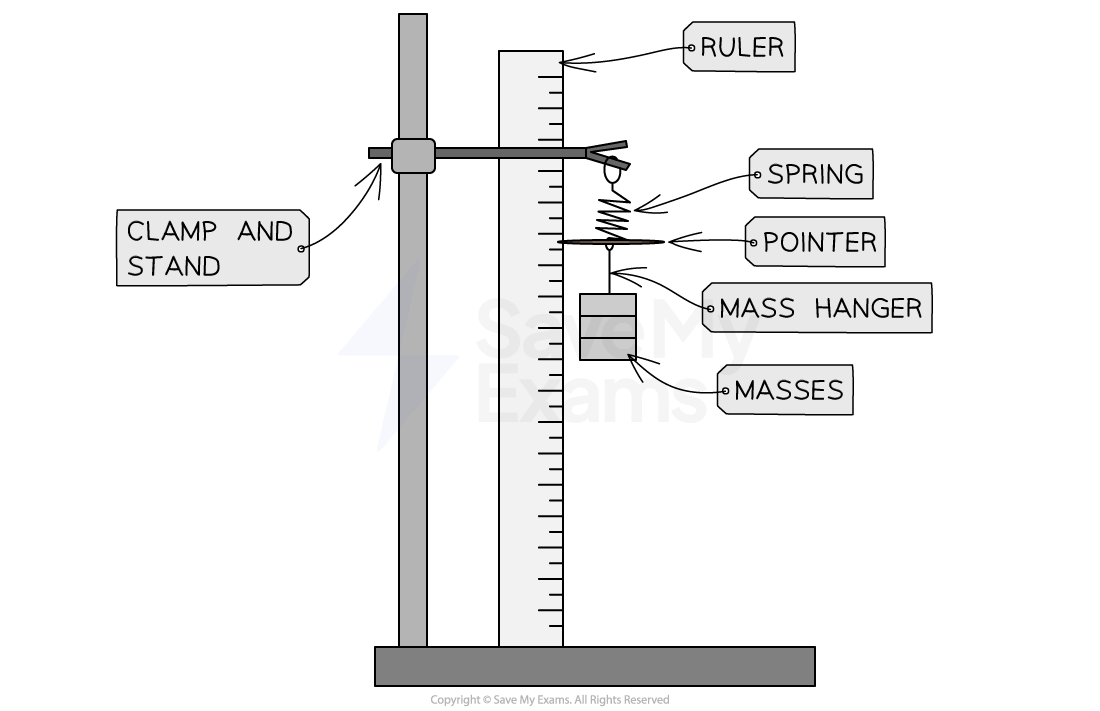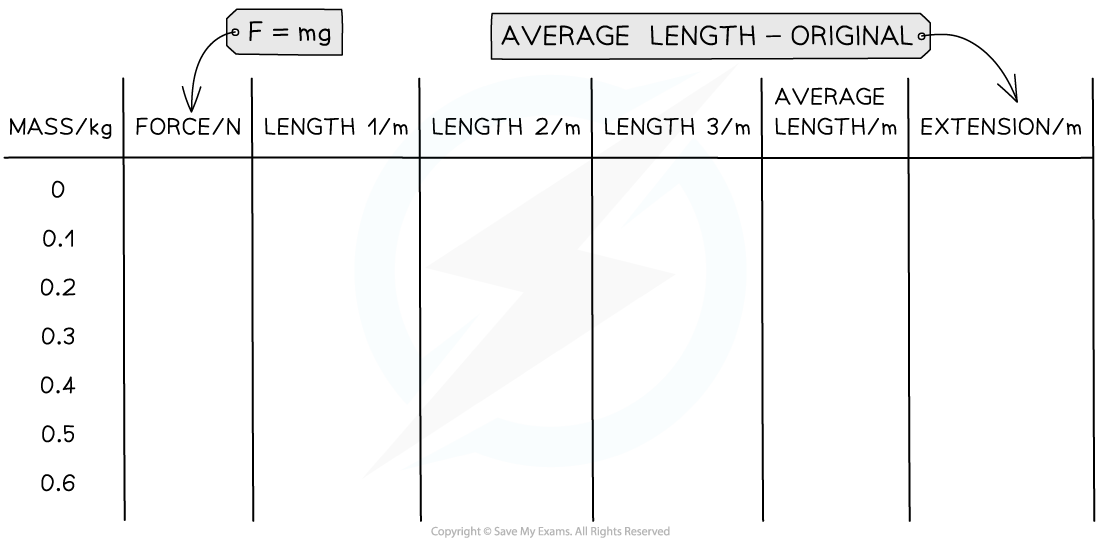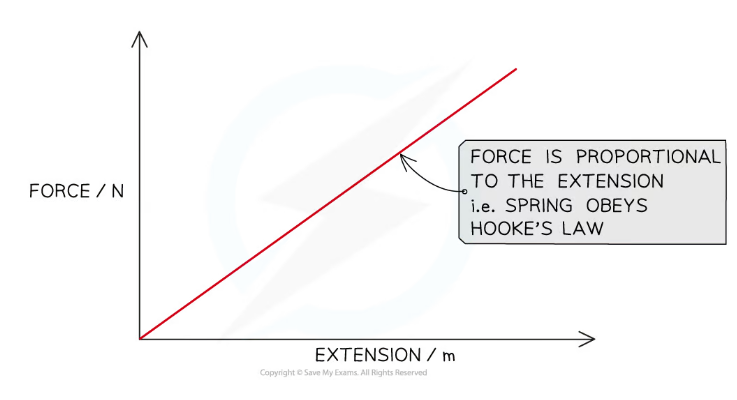Investigating the Force-Extension Graph for a Spring (WJEC GCSE Science (Double Award)) : Revision Note
Specified Practical: Investigating the Force-Extension Graph for a Spring
Aim of the Experiment
This experiment aims to investigate the relationship between the force and extension of a spring F = kx
Also known as Hooke's Law
Variables:
Independent variable = Force, F
Dependent variable = Extension, x
Control variables:
Spring with spring constant, k
Equipment used and set up
Method of taking measurements
Equipment List
Equipment | Purpose |
|---|---|
Clamp stand, boss and clamp | To hang the spring and masses from |
Ruler | To measure the extension of the spring |
Spring | To measure the extension of |
6 × 100 g masses | To apply a force to the spring |
100 g mass hanger | To hold the additional masses |
Pointer | To accurately read the extension from the ruler |
Equipment Used for Force and Extension of a Spring Investigation

Fixing the ruler to the clamp stand will reduce movement in the ruler and therefore reduce errors in measurement
Method
Attach the ruler to the clamp stand, hang the spring, and attach the pointer to the bottom of the spring
Measure the initial length of the spring with no masses attached
Add the mass hanger (of mass 100 g) and record the length of the spring
Remove and repeat 3 times to calculate an average length
Subtract the initial length of the spring from the average length to calculate the extension
Add a 100 g mass to the mass hanger and record the length of the spring
Repeat the process adding an additional 100 g mass each time
An Example Table of Results

A suitable table of results must contain the calculations for force and extension
A Table of Expected Results
Mass /kg | Force /N | Length 1 /m | Length 2 /m | Length 3 /m | Average Length /m | Extension /m |
|---|---|---|---|---|---|---|
0 | 0 | 0.03 | 0.03 | 0.03 | 0.030 | 0 |
0.1 | 1.0 | 0.06 | 0.07 | 0.06 | 0.065 | 0.035 |
0.2 | 2.0 | 0.13 | 0.12 | 0.12 | 0.125 | 0.095 |
0.3 | 3.0 | 0.19 | 0.19 | 0.19 | 0.190 | 0.160 |
0.4 | 4.0 | 0.24 | 0.25 | 0.24 | 0.245 | 0.215 |
0.5 | 5.0 | 0.31 | 0.30 | 0.31 | 0.305 | 0.275 |
0.6 | 6.0 | 0.36 | 0.37 | 0.36 | 0.365 | 0.335 |
0.7 | 7.0 | 0.40 | 0.41 | 0.40 | 0.405 | 0.375 |
Analysis of Results
The force, F added to the spring is the weight of the mass
The weight is calculated using the equation:
W = mg
Where:
W = weight in Newtons (N)
m = mass in kilograms (kg)
g = gravitational field strength on Earth in Newtons per kg (N/kg)
The extension of the spring is calculated using the equation:
extension = final length – original length
Plot a graph of the force against the extension
Draw a line of best fit
If the graph has a linear region (a straight line with an increasing gradient), then the force is proportional to the extension and the spring obeys Hooke's Law
An Example Force-Extension Graph for a Spring

The graph is a straight line that goes through the origin which shows that the extension of the spring is directly proportional to the force applied
Evaluating the Experiment
Systematic Errors:
Make sure the measurements on the ruler are taken at eye level to avoid parallax error
Random Errors:
The precision of the experiment is improved with the use of a pointer at the bottom of the spring
Wait a few seconds for the mass to become stationary after it is added, before taking the readings for its length
Check that the spring has not gone past its limit of proportionality otherwise, it has been stretched too far and will no longer obey this relationship
Make sure the measurements are taken from the same point on the bottom of the spring every time
Safety Considerations
Wear goggles during this experiment in case the spring snaps
Stand up while carrying out the experiment making sure no feet are directly under the masses
Place a mat or a soft material below the masses to prevent any damage in case they fall
Use a G clamp to secure the clamp stand to the desk so that the clamp and masses do not fall over
As well as this, place each mass carefully on the hanger and do not pull the spring too hard so it breaks or pulls the apparatus over
Do not pull the masses down further with your hand
Do not exceed the maximum load of the spring, roughly 700 g
Examiner Tips and Tricks
Remember - the extension measures how much the object has stretched by and can be found by subtracting the original length from each of the subsequent lengths.
A common mistake is to calculate the increase in length each time instead of the total extension – if each of your extension is roughly the same then you might have made this mistake!

You've read 0 of your 5 free revision notes this week
Sign up now. It’s free!
Did this page help you?
